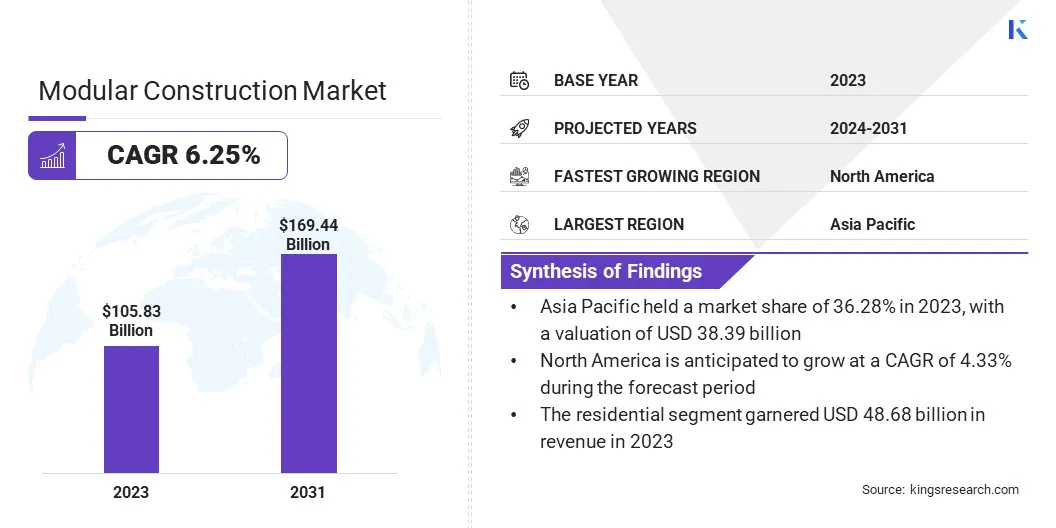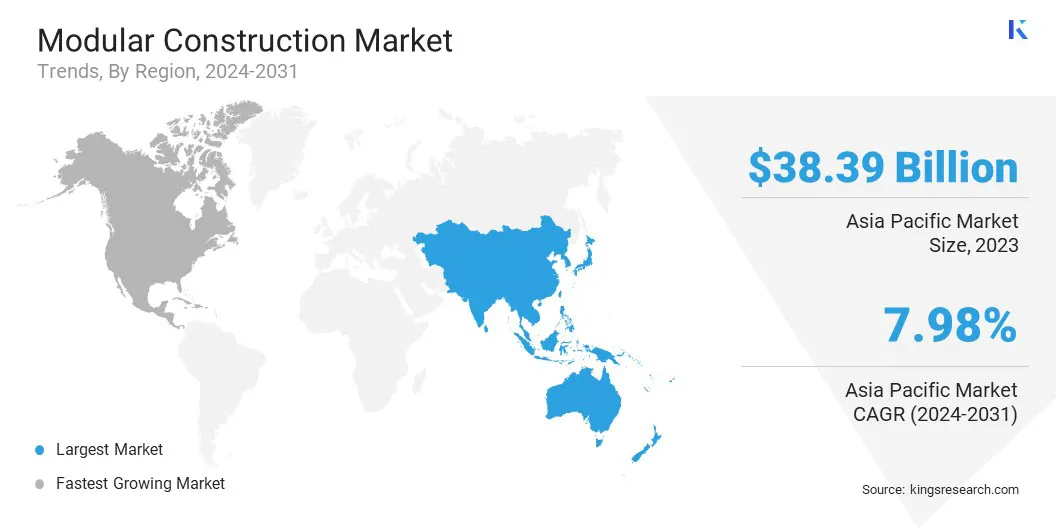Modular Construction Market Size
The global Modular Construction Market size was valued at USD 105.83 billion in 2023 and is projected to reach USD 169.44 billion by 2031, growing at a CAGR of 6.25% from 2024 to 2031. In the scope of work, the report includes solutions offered by companies such as Guerdon, LLC, Laing O'Rourke, ATCO LTD., RED SEA INTERNATIONAL, Bouygues Construction, VINCI Construction Grands Projets, Skanska AB, Algeco, KLEUSBERG GmbH & Co. KG, Katerra, Lendlease Corporation and Others.
The demand for rapid and cost-effective construction solutions is a major driver propelling the growth of the market. The market is witnessing increased demand due to rising urbanization, infrastructure needs, and a growing emphasis on sustainable and cost-effective building solutions. This method offers a quicker and more efficient alternative to traditional construction, making it particularly appealing in urban areas where space constraints and construction disruptions are prevalent.
Moreover, advancements in technology and manufacturing processes have enhanced the quality and customization options of modular construction, further driving its adoption. The market is expected to grow fueled by infrastructure development initiatives, and the growing recognition of its benefits in terms of speed, cost-effectiveness, and environmental sustainability. As the industry continues to innovate and address challenges, such as regulatory frameworks and supply chain optimization, the outlook remains optimistic for sustained growth in the modular construction market.

Modular construction involves assembling buildings or structures using prefabricated modules or components manufactured off-site in a controlled environment. These modules, typically constructed using materials such as steel, wood, or concrete, are transported to the construction site for assembly. Modular construction encompasses various types, such as volumetric modular construction, wherein complete room modules are fabricated off-site, and panelized modular construction, wherein wall panels or sections are prefabricated.
This construction method finds applications across residential, commercial, and institutional sectors, such as housing developments, hotels, schools, offices, and healthcare facilities. Its versatility, efficiency, and ability to deliver high-quality structures with reduced construction time and cost make modular construction a preferred option among developers and contractors pursuing innovative solutions to meet diverse construction needs.
Analyst’s Review
The modular construction market is experiencing robust growth driven by increasing urbanization, demand for rapid construction solutions, and technological advancements. The market landscape is characterized by numerous market players offering various modular construction solutions tailored to meet varying project requirements.
As governments and private sector entities seek to address housing shortages, infrastructure requirements, and sustainability goals, modular construction is being preferred due to its ability to deliver projects more efficiently and cost-effectively than traditional construction methods. With favorable market conditions and supportive regulatory frameworks in various regions, the global market is poised to grow steadily.
Modular Construction Market Growth Factors
Urbanization is a significant driver fueling the demand for efficient urban infrastructure, driving the growth of the modular construction market. In light of rapid urbanization, traditional construction methods can result in extended project timelines, cost overruns, and disruptions to urban environments. Modular construction solves these challenges by providing faster and more efficient construction processes that minimize disruption to urban areas.
By prefabricating building components off-site, modular construction reduces construction time and costs while improving quality control. This makes it an attractive option for developers and governments aiming to meet the infrastructure needs of rapidly growing urban populations while maximizing efficiency and minimizing environmental impact.
Regulatory and permitting challenges present significant barriers to market expansion. Regulatory frameworks vary widely between regions and are time-consuming, particularly for innovative construction methods such as modular construction. Certain challenges related to zoning restrictions, building codes, and permitting processes specific to modular construction methods are hindering product adoption.
Another restraint impeding industry growth is the resistance from traditional construction stakeholders and local authorities unfamiliar with modular construction practices. However, collaboration between industry stakeholders, policymakers, and regulatory bodies to streamline processes, standardize regulations, and raise awareness about the benefits of modular construction for efficient and sustainable urban development is likely to bolster market growth.
Modular Construction Market Trends
The emergence of sustainable and eco-friendly modular construction solutions is a notable trend shaping the modular construction market. With sustainability becoming increasingly important in the construction industry, modular construction is gaining popularity as it is more environment friendly than traditional construction methods. Modular construction minimizes material waste, reduces energy consumption, and improves resource efficiency by manufacturing building components in a controlled factory environment.
Modular construction allows for the integration of eco-friendly materials and technologies, such as recycled materials, energy-efficient systems, and renewable energy sources. This enables developers to construct buildings with lower carbon footprints and enhanced environmental performance, which is fueling product uptake.
Segmentation Analysis
The global market is segmented based on type, material, end-use, and geography.
By Type
Based on type, the market is categorized into permanent and re-locatable. The permanent segment dominated the modular construction market with a share of 78.77% in 2023, owing to the widespread adoption of modular construction techniques in various permanent building applications. Permanent modular construction involves assembling buildings or structures built for long-term use, such as residential & commercial structures, educational facilities, and healthcare centers.
These permanent structures offer the same quality, durability, and functionality as traditionally constructed buildings with the added benefits of faster construction timelines, cost savings, and enhanced sustainability. The versatility and adaptability of permanent modular construction have made it a preferred choice for developers and building owners seeking efficient and scalable solutions to meet diverse construction needs across different sectors and applications.
By Material
Based on material, the market is bifurcated into steel, wood, concrete, and others. The concrete segment is anticipated to witness considerable growth at 7.04% CAGR over the forecast period supported by the increasing demand for durable and fire-resistant construction materials, advancements in concrete technology, and the adoption of precast and prestressed concrete components in modular construction projects.
Additionally, the versatility of concrete allows for the construction of various building types and structures, which is fueling its adoption in the market. The surging demand for cost-effective and sustainable building solutions is anticipated to further aid segment growth.
By End-Use
Based on end-use, the modular construction market is divided into residential, commercial, and industrial. The residential segment garnered the highest revenue of USD 48.68 billion in 2023 spurred by rapid urbanization, population growth, and the increasing demand for affordable housing solutions, which is fueling the adoption of modular construction techniques in the residential sector.
Modular construction offers advantages such as faster project delivery, cost efficiency, and scalability, which has made it an attractive option for residential developers seeking to meet housing demand quickly and cost-effectively. Additionally, government initiatives promoting affordable housing and sustainable construction practices support the residential segment's growth in the market.
Modular Construction Market Regional Analysis
Based on region, the global market is classified into North America, Europe, Asia-Pacific, MEA, and Latin America.

The Asia Pacific modular construction market share stood around 36.28% in 2023 in the global market, with a valuation of USD 38.39 billion, due to several factors driving the growth of the market in the region. Rapid urbanization, population growth, and increasing infrastructure investments are key drivers fueling the demand for modular construction solutions across Asia-Pacific. Countries such as China, India, and Southeast Asian nations are experiencing significant urbanization trends, leading to a surge in construction activities and infrastructure development projects.
Modular construction offers a viable solution to address the pressing need for fast, efficient, and cost-effective building solutions in densely populated urban areas. Asia-Pacific emerges as a leading market for modular construction, offering substantial growth opportunities for industry players amidst the region's evolving construction landscape.
North America is likely to experience significant growth at a 4.33% CAGR between 2024 and 2031 primarily owing to increasing demand for sustainable and cost-effective construction solutions. The region's robust construction industry, technological advancements, and supportive regulatory environment are contributing to the growth of the regional modular construction industry.
Moreover, rising concerns about housing affordability, urbanization, and infrastructure needs are creating opportunities for advancements in modular construction to address these challenges effectively. Developers, contractors, and policymakers are leveraging the benefits of modular construction in terms of speed, efficiency, and sustainability, which is poised to support regional market growth over the review period.
Competitive Landscape
The modular construction market report will provide valuable insight with an emphasis on the fragmented natureof the industry. Prominent players are focusing on several key business strategies such as partnerships, mergers and acquisitions, product innovations, and joint ventures to expand their product portfolio and increase their market shares across different regions.
Manufacturers are adopting various strategic initiatives, including investments in R&D activities, the establishment of new manufacturing facilities, and supply chain optimization to strengthen their market standing.
List of Key Companies in Modular Construction Market
- Guerdon, LLC
- Laing O'Rourke
- ATCO LTD.
- RED SEA INTERNATIONAL
- Bouygues Construction
- VINCI Construction Grands Projets
- Skanska AB
- Algeco
- KLEUSBERG GmbH & Co. KG
- Katerra
- Lendlease Corporation
Key Industry Developments
August 2023 (Partnership): Red Sea International Company signed a USD 7.76 million contract with Fundamental Installation for Electric Work Company (First Fix), a local construction firm, to design, manufacture, supply, and install prefabricated modular buildings.
The Global Modular Construction Market is Segmented as:
By Type
By Material
- Steel
- Wood
- Concrete
- Others
By End-Use
- Residential
- Commercial
- Industrial
By Region
- North America
- Europe
- France
- U.K.
- Spain
- Germany
- Italy
- Russia
- Rest of Europe
- Asia-Pacific
- China
- Japan
- India
- South Korea
- Rest of Asia-Pacific
- Middle East & Africa
- GCC
- North Africa
- South Africa
- Rest of Middle East & Africa
- Latin America
- Brazil
- Argentina
- Rest of Latin America


